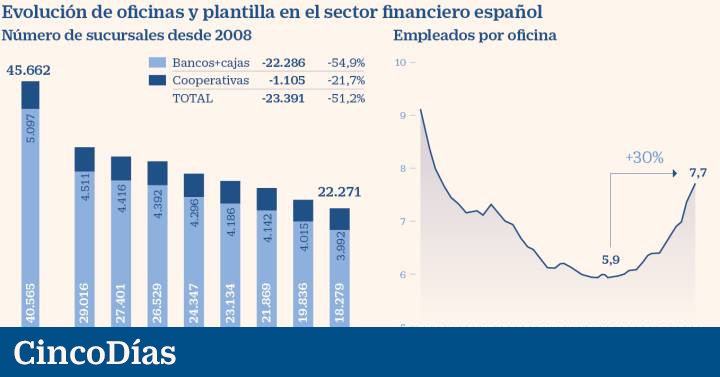The financial crisis that began between 2007 and 2008 was the trigger for the radical change in banking, which has worsened over these 12 years, with the closure of financial entities, mergers, digitization and Covid.
A change that continues, and that represents a total turnaround in a sector that was used to having a store in the best corners of any town, to taking advantage of any housing development to open a branch or to attract or steal customers from one bank to another thanks to the proximity of the premises.
But this expansion strategy like an oil slick, as it was defined then, has not only gone down in history, but has now turned against them in several cases.
In 2008 the Spanish financial sector had 45,662 branches.
It was the highest number in the history of the financial sector.
From that figure, year after year the trickle with more or less intensity of branch closures has been unstoppable, and will continue to be so.
By the end of 2020, the total number of branches had fallen to 22,271, after closing a total of 23,391 bank locations since 2008.
For the first time, more offices have been closed than those that operated at the end of last year.
51.2% of the dense network of existing branches in Spain have given the bolt.
Now, the old savings banks (CaixaBank, Bankia, Ibercaja, Liberbank, Unicaja, Abanca, Kutxabank and the only two surviving savings banks Ontinyent and Pollença) have a total of 10,079 branches, while traditional banks currently have 8,200 agencies, and credit unions, 3,992.
The old savings banks have been the ones that have reduced their presence the most
New screen One
would have to go to March 1977 to find a smaller number.
But the tsunami of closures has not passed.
For this year a new and higher screening of branches is expected.
Only Santander will close just over 1,000 stores (its adjustment began in February).
To this will be added another around 1,400 closings of CaixaBank and Bankia after their merger, which will take place this month.
BBVA will also close a minimum of another 500 agencies in the coming months.
Ibercaja will close 199 until June 2022, Sabadell has plans to close another 300 at least, although the figure is unconfirmed.
The merger of Unicaja and Liberbank will also lead to the closure of some 400 branches.
Other small banks will also follow this closure strategy due to the search for efficiency and profitability in the sector, and the change in customer habits, especially as a result of Covid, which has accelerated its digitization.
Spanish banking will thus become a great financial platform, with some branches.
“At the end of this year, the sector will have about 18,300 branches or less.
It would be necessary to move to 1975 to count a lower number ”, explains a financial director of a prominent bank.
That year, 17,478 branches operated in Spain, and the expansive boom of savings banks was still far away.
By autonomous communities, Catalonia has been the one that has suffered the highest number of closures.
In total, 5,169, which means that since 2008 it has had 63.8% fewer banks.
In Madrid, 3,304 were closed in this period, 54.9% of what it had 12 years ago.
Andalusia has suffered the closure of 3,244 offices, 57.4%, according to data from the Bank of Spain.
Although the Andalusian community is the one that still has the most operational branches, 3,760, while in Catalonia there are 2,929, and in Madrid 2,719.
Of course, since 2008, and especially since the last two years, bank branches are getting bigger and bigger and with a greater number of employees.
Thus, they go from 5.9 workers per branch, on average, to 7.7, according to data as of September, the latest available in the workforce.
The mega-offices are mainly concentrated in Madrid, where the number of workers per branch is 15.9, although it must also be taken into account that it is in this community where the central services of the banks are concentrated, the same as in Catalonia, with 9.5 employees per branch, but there are also central services for some entities, such as CaixaBank or Sabadell.
The next community with the most employees per banking agency is the Basque Country, with 7.3, but it is already below the country's average.
Extremadura, meanwhile, is the autonomous community with the fewest employees per branch, 3.7.
In terms of workforce, adjustments, like branch closures, are traditionally one of the main ways to save costs and gain efficiency.
For now, neither the Bank of Spain nor the European Central Bank have published updated data at the end of 2020 of the templates.
But with data from September, the exits of employees have risen to almost 100,000 employees since 2008.
At present, and since the end of 2020, banks have announced or have plans to destroy some 15,000 jobs.
In this way, the total workforce in this sector would be below 160,000 jobs.
Closure plans for more than 5,000 stores
Notices
.
The continuous messages from the European Central Bank, the Bank of Spain, the European Banking Authority (EBA) and experts are also exerting pressure on the sector that has decided to step on the accelerator in its new adjustment.
Added to which is the change in customer habits, who have found digitization to be a quick way to operate with their entity.
Throttle.
After announcing the merger of CaixaBank and Bankia, the closure plans of Spanish banks amounted to around 4,000 branches between 2020 and 2021, to bring the number of branches at the end of this year to 1977 levels. Now, the plans have been accelerated and all have increased the number of premises to be closed. In fact, now in both years, between closings and closure plans, they exceed 5,000.















